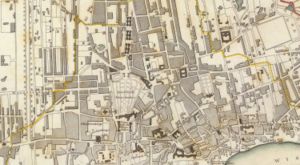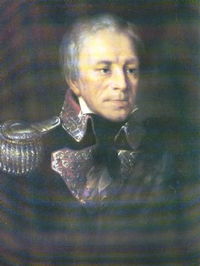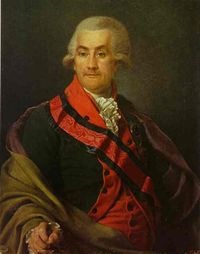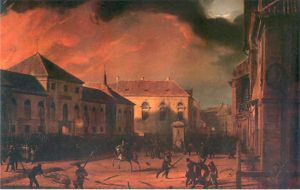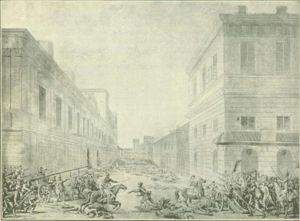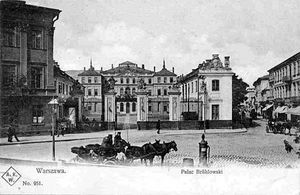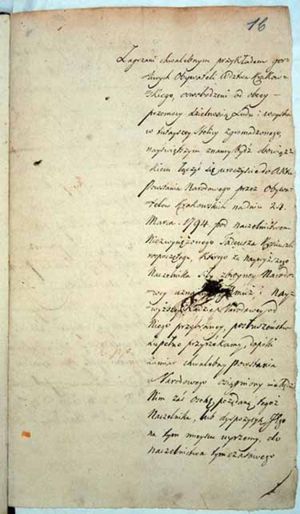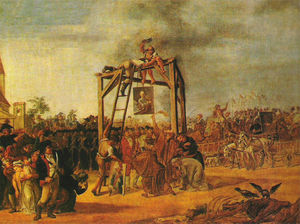Warsaw Uprising (1794)
2007 Schools Wikipedia Selection. Related subjects: General history
| Warsaw Uprising of 1794 | |||||||
|---|---|---|---|---|---|---|---|
| Part of Kościuszko's Uprising | |||||||
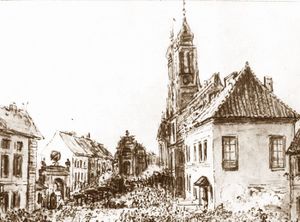 Fights at Krakowskie Przedmieście, a contemporary sketch by Jan Piotr Norblin. |
|||||||
|
|||||||
| Combatants | |||||||
| Poland | Imperial Russia | ||||||
| Commanders | |||||||
| Stanisław Mokronowski, Jan Kiliński |
Iosif Igelström | ||||||
| Strength | |||||||
| 3,500 soldiers, ~2,500 militia |
7,000 soldiers | ||||||
| Casualties | |||||||
| 507 soldiers killed and 437 wounded, ~700 civilians killed |
2,000-4,000, 2000 captured |
||||||
| Kościuszko Uprising |
|---|
| Racławice – Warsaw – Wilno – Greater Poland – Szczekociny – Chełm – Krupczyce – Terespol – Maciejowice – Praga |
The Warsaw Uprising of 1794 (otherwise called the Warsaw Insurrection, Polish: insurekcja warszawska) was an armed Polish insurrection at the onset of Kościuszko's Uprising by the people of the city. Supported by the Polish Army, it aimed to throw off Russian control of Warsaw, the capital of Poland. It started on April 17, 1794, soon after Tadeusz Kościuszko's victory at Racławice. Although the Russian forces were more numerous and better equipped, the Polish regular forces and militia, armed with rifles and sabres from the Warsaw Arsenal, nonetheless inflicted heavy losses on the surprised enemy garrison. Russian soldiers found themselves under crossfire, shot from all sides and buildings, and several units broke early and suffered heavy casualties during the retreat.
Tomasz Maruszewski, Kościuszko's envoy, Ignacy Działyński, and others had been laying the groundwork for the uprising since the spring of 1793. They succeeded in encouraging popular support: the National Militia was formed out of several thousands of volunteers and was led by Jan Kiliński, a master shoemaker by trade and one of the most notable burghers of the time. Apart from the militia, the most famous units to take part in the liberation of Warsaw were formed of Poles that had previously been forcibly conscripted into the Russian service. An eye-witness of the fights in Warsaw was Jan Piotr Norblin de la Gourdaine, a French-born Polish painter who created a set of sketches and paintings depicting the struggles.
Within hours, the fighting spread from a single street at the western outskirts of Warsaw's Old Town to the entire city. A part of Russian garrison was able to retreat to Powązki under the cover of Prussian cavalry, but most of the garrison was trapped inside the city. The isolated Russian forces continued to resist in several parts of the city for two more days.
History
Prelude
Following the Second Partition of Poland of 1793, the presence of Prussian and Imperial Russian garrisons on Polish soil was almost continuous. Although foreign influence at the Polish court, often in the form of Russian ambassador Nikolai Repnin, had been strong for many years, it was not until the partitions of Poland that it started to influence not only the Polish government and szlachta (nobility), but the entire people. The presence of foreign occupation forces contributed both to economic collapse of the already-weakened state and to growing radicalisation of the population of Warsaw.
Upon receiving news of Kościuszko's proclamation in Kraków (March 24) and his subsequent victory at Racławice (April 4), the tension in Warsaw grew rapidly. Polish king Stanisław August Poniatowski was opposed to the idea of Kościuszko's uprising, and together with the Permanent Council issued a declaration on April 2, condemning it. The king dispatched Hetman Piotr Ożarowski and marshal of the Permanent Council Józef Ankwicz to Iosif Igelström, the Russian ambassador and commander of all Russian occupation forces in Poland, with a proposal to evacuate both the Russian and Polish troops loyal to the king to a military encampment at Nowy Dwór Mazowiecki. There the king and his court, as well as the members of pro-Russian faction and the leaders of the Confederation of Targowica could safely await for the tensions to dissipate.
However, Igelström disagreed with the plan and saw no need for Russians to evacuate Warsaw. He sent a corps under Gen. Aleksandr Khrushchev to intercept Kościuszko and prevent him from approaching Warsaw. He also ordered increased surveillance of suspected supporters of the uprising, and censorship of all mail passing through Warsaw. Finally, Igelström issued orders for the arrest of those whom he suspected of any connection with the insurrection. Among them were Gen. Ignacy Działyński, king's chamberlain Jan Walenty Węgierski and Stanisław Potocki, some of the more prominent political leaders of the time. At the same time Russian forces started preparations to disarm the weak Polish garrison of Warsaw under General Stanisław Mokronowski by seizing the Warsaw Arsenal at Miodowa Street. However, these orders only made the situation worse as they were leaked to the Poles.
The Russian forces prepared a plan to seize the most important buildings in the city and secure it until further reinforcements could arrive from Russia. General Johann Jakob Pistor suggested that the barracks of "unsafe" Polish units be surrounded and the units disarmed, and the Warsaw Arsenal captured to prevent the revolutionaries from seizing arms. At the same time bishop Józef Kossakowski, known for his pro-Russian stance, suggested that on April 19, that is the Holy Saturday, the churches be surrounded with troops and all suspects attending the mass be arrested.
On the Polish side, weakened by the arrests of some of its leaders, both the radical Polish Jacobins and the centrist supporters of King Stanisław August Poniatowski began preparing plans for an all-out attack on the Russian forces to drive them from Warsaw, still, in theory, the capital of an independent state. Kościuszko already had supporters in Warsaw, including Tomasz Maruszewski, his envoy who was sent to Warsaw with a specific mission to prepare the uprising. Maruszewski created the Revolution Association (Związek Rewolucyjny), organzing the previously independent anti-Russian factions. The Association included among its members various high-ranking officers from the Polish forces stationed in Warsaw. Among them were Michał Chomentowski, Gen. Krystian Godfryd Deybel de Hammerau, Józef Górski, Capt. Stanisław Kosmowski, Fryderyk Melfort, Dionizy Poniatowski, Lt. Grzegorz Ropp and Józef Zeydlitz. Among the most influential partisans of the uprising was General Jan August Cichowski, the military commander of the Warsaw's garrison. Together with General Stepan Stepanovich Apraksin he devised a plan of defence of the city against the revolutionaries, but managed to convince the Russians to leave the Arsenal, the Royal Castle and the Gunpowder Depot defended by the Polish units. Cichowski also managed to undermine the Russian plan to reduce the number of soldiers serving in the Polish units, which also added to the later Polish successes. Also, a prominent burgher, shoemaking master Jan Kiliński, started gathering support from other townsfolk. The king, however, remained passive, and subsequent events unfolded without any support - or opposition - from him.
Opposing forces
Due to the fact that a large part of the Polish forces consisted of irregular militia, the exact number of the troops fighting on Polish side is hard to estimate. However, there are pay rolls of the Russian garrison preserved, which give a fairly accurate number of regular soldiers available to Igelström.
The Polish force consisted of roughly 3000 men at arms and 150 horses, most of them from the 10th Regiment of Foot and the 4th Regiment of Front Guard. In addition, in the eastern borough of Praga there were 680 men and 337 horses of the royal uhlan squadrons. The latter units crossed the Vistula and took part in the fights, but served as a standard infantry as their horses had to be left on the other side of the river.
According to the Russian pay roll found after the uprising in the Russian embassy and published in the Gazeta Wolna Warszawska newspaper soon afterwards, the Russian garrison had 7948 men, 1041 horses and 34 guns. In addition, Igelström could request assistance from a Prussian unit of Gen. Fiedrich von Wölcky stationed to the west of the city in the fields between Powązki and Marymont. The latter unit had roughly 1500 men and 4 guns.
Opening moves
After the Russian plan of surrounding the churches on Saturday was discovered by the Poles, it was decided that the uprising start immediately. On Holy Wednesday the Polish garrison was secretly provided with volleys and artillery charges and overnight was dispatched to various parts of the city. The Russians were conscious of the preparations for the uprising as their troops were also equipped with additional ammunition. Half past 3 o'clock some 20 Polish dragoons left the Mirów barracks and headed for the Saxon Garden. Encountered by a small Russian force equipped with two cannons guarding the Iron Gate, the squadron charged the Russian positions and captured the guns. Soon afterwards the remainder of the Royal Horse Guard regiment left the barracks on foot and headed in two directions: towards the outer gates of the city at Wola and towards the Warsaw Arsenal, where the Russian forces were preparing an assault. The latter force was also joined by a small troop of National Cavalry under Col. Gizler, who crossed the Vistula overnight.
At 5 o'clock the planned Russian assault on the Arsenal was indeed started, but was repelled by unexpected opposition from Polish forces. After the first shots, the crew of the Arsenal started giving out arms to the civilian volunteers, who quickly joined the fights. The arsenal was secured, but the Polish plan to catch most of the Russian soldiers on the streets rather than in buildings and barracks failed. One of such groups armed with a cannon broke through the Warsaw's Old Town to Krasiński Sq., two additional started marching along the Długa Street. Their action spread the uprising to all parts of the city. Until half past 6 o'clock the regular units and the militia clashed with the Russian outposts at Nalewki, Bonifraterska, Kłopot and Leszno streets.
The initial clashes caused much confusion as not all forces involved had been notified of the plans of both sides. Among such units was the Royal Foot Guard unit, which broke through to the Castle Square, where it was to await further orders. The small troop pledged to defend the monarch as soon as he appeared at the Castle's courtyard, however, on hearing the sounds of a battle nearby, the unit left the king and joined the fights at Miodowa Street; The Russian forces, pushed back after their initial failure at the gates of the Arsenal, withdrew towards Miodowa Street, where they amassed in front of Igelström's palace. There they were shelled by a small Polish force stationed in the gardens of the Krasiński's Palace, but managed to destroy the Polish unit and successfully reorganize and rally. However, the chaos in the Russian ranks could not be eliminated as Igelström's headquarters had been cut out from the rest of the city and he could not send request for reinforcement to Russian units stationed outside of the city centre and the Russian chain of command had been practically paralysed. By 7 o'clock the confusion was partially cleared and heavy fights at Miodowa street turned into a regular battle in the vicinity of both the Arsenal and Igelström's headquarters, as both sides struggled to secure both buildings. Three Russian assault groups, each of them roughly battalion-strong, attacked the Arsenal from three sides: from Tłomackie, along Miodowa Street and from Franciszkańska Street. However, all the Russian assaults were repelled with heavy losses on both sides and the Poles started a counter-attack towards the Russian positions at Miodowa, Senatorska, Leszno and Podwale Streets, but with little success.
The assault on Leszno street was aimed at the Russian battalion occupying positions in front of the Carmelite church. In the effect of the heavy, several hours long close quarters struggle, the Russian forces were forced to retreat to the church itself, where the fights continued. Finally the Russian soldiers surrendered and only a small detachment composed primarily of officers continued the fight inside the church, where most of them perished to the last man. Also the Russian battalion under Maj. Titov, stationed at Bonifraterska street, had been attacked around 7 o'clock by the Poles. In the effect of a four hours long fight the Russians retreated towards the western outskirts of the city.
Meanwhile, at 6 o'clock the Polish 10th Regiment of Foot under Col. Filip Hauman left its barracks at Ujazdów to the south of the city centre, and started its march towards the Royal Castle. As an effect of the chaos in Russian ranks, it reached Nowy Świat and Świętokrzyska Streets unopposed by Russian units stationed there, as the Russian commanders did not know what to do. It was finally stopped by a Russian force at Krakowskie Przedmieście Street, consisting of no less than 600 men and 5 pieces of artillery, and commanded by Gen. Miłaszewicz. The Russian force was strategically dislocated on both sides of the street, in both the Casimir's Palace (modern rectorate of the Warsaw University) and in front of the Church of the Holy Cross. Col. Hauman started lengthy negotiations with the Russian commander asking him to allow the Polish forces to pass. However, the negotiations were finally broken and at 8 o'clock the Polish regiment assaulted the Russian positions. After a skirmish that ensued the Polish unit was partially dispersed and had to retreat. Parts of the unit under Maj. Stanisław Lipnicki retreated to the Dominican Church, where the fights continued. Other troop under Lt. Sypniewski broke through to Branicki's Palace, yet others found their way further towards the Old Town, outflanking the Russians. Because of that, the Russian infantry under Gen. Miłaszewicz and a small cavalry force under Prince Gagarin, though victorious, found themselves under crossfire and surrounded. In addition, a small yet loud militia force under Jan Kiliński appeared on their rear and all of the Polish units in the area assaulted the Russians from all directions, which resulted in almost complete destruction of the Russian units. General Miłaszewicz himself was wounded as he was trying to retreat with the remnants of his force towards the Casimir's Palace, while Prince Gagarin retreated with some cavalrymen towards the Saxon Garden, where they were ambushed by the civilians and killed almost to the last man. The 10th Regiment then proceeded towards the Castle Square, where it took part in the fights against smaller Russian forces in the Old Town.
Fights in the city centre
The victory of the 10th Regiment marked a turning point of the uprising, as it broke the morale of the Russian forces. After noon the fights in front of Igelström's headquarters, at Miodowa street and for the Arsenal continued as both sides drew reinforcements from all parts of the town. Russian units there put up the strongest defense and although they were forced to retreat in the direction of the Franciscan church, they repelled Polish early attacks and captured Krasiński's Palace which Poles attempted to use to take them under crossfire. At the same time the palace's garden remained in Polish hands and heavy fights spread to that area as well. In other parts of the city smaller Russian forces defended themselves in isolated manors, as was the case of Szanowski's house at the Vistula in the borough of Powiśle, where a small Russian troop offered fierce resistance against the 10th Regiment until late afternoon. Nearby, a Russian force under Maj. Mayer, consisting of roughly two companies and armed with two cannons, fortified itself in the Kwieciński's Baths, where it defended itself for several hours. After repeated charges by the 10th Regiment, the Russian commander was left with no more than 80 men, with whom he retreated to the other side of the river.
In the meantime, the king, together with some members of the Targowica Confederation took refuge in the Warsaw Castle (among them were Piotr Ożarowski, Józef Ankwicz, Great Crown Marshall Fryderyk Józef Moszyński and king's brother Kazimierz Poniatowski). From there they tried to restore peace, but without any success. Poniatowski nominated two trusted people to take command of the troops: Ignacy Wyssogota Zakrzewski became the mayor of Warsaw, and general Stanisław Mokronowski became the commander-in-chief of the Warsaw troops, but both quickly decided to support the uprising.
At the same time more than half of the Russian forces were amassed by Gen. Ivan Novitskiy at the western end of the Jerusalem Avenue. Roughly 4000 men were withdrawn there without a single shot fired. Among the units rallied there were units that were to secure the entire southern part of Warsaw, including forces under Lt.Col. Kasztoliński and von Klugen, parts of Igelström's personal guard and the remnants of the force to take part in the battle against the 10th Regiment, commanded by Maj. Bago. Novitskiy, after several hours of wavering, finally organized a relief force of roughly 3000 men and 10 cannons, and started a march towards the city centre. The column crossed Marszałkowska Street unopposed and reached the Saxon Square. There it was met by a negligible unit of not more than 100 civilians armed with a single 6 pounder cannon, commanded by Captain of Artillery Jacek Drozdowski. The Polish unit opened fire from its' single cannon and started gradually retreating across the square towards the Brühl's Palace on its' northern edge, firing all the way. At the same time the Russian commander did not issue any orders and his column simply stopped under fire. Although much inferior in both numbers, training and equipment, Drozdowski's unit was not attacked by the Russian force, as Novitskiy finally lost control over his troops. The Russian soldiers broke their ranks and seized the undefended Saxon Palace, where they seized the cellars full of alcohol. The Poles continued to shell them with artillery fire for almost 3 hours, without being attacked. Finally, when a company of the 10th Regiment returning from Powiśle appeared at Królewska Street, the Russians started a disorganized retreat towards the Jerusalem Avenue, leaving Igelström to his own fate.
The retreat of the Russian unit allowed the Poles to repel other assaults of Russian forces as well, including the attack of roughly 1000 men from the Warsaw's New Town towards the northern gate of the Old Town. Although the Russian force finally managed to break through to the Old Town, it lost all of its guns and more than 50% of men. Also the repeated assaults on the Arsenal from Miodowa Street, commanded by Gen. Tishchev, were repelled. The Russians, approaching in three columns, did not coordinate their manoeuvres, which allowed the Polish crew to deal with them separately, one by one. The first column under Tishchev approached the Arsenal at 3 o'clock from Miodowa street. Although one of the turrets of the building exploded, the Poles managed to repel the assault in half an hour, before the Russians gathered reinforcements. The second Russian column approached the Arsenal through the Krasińskis' Garden, but was stopped by a massed fire from several cannons, hidden in the bushes. The third Russian battalion commanded by Tishchev personally approached the Arsenal from the West, along the Leszno street, where it was stopped by the Royal Guard. After a fierce fight Tishchev was heavily wounded (a cannon ball ripped his leg off) and died of wounds soon afterwards, while the remainder of his force surrendered to the Poles.
Under such circumstances the Poles started a counter-attack aimed at capturing Igelström's palace and the positions of the forces he managed to gather around him. Among them was a battalion of Johann Jakob Pistor, a battalion drawn from Marywil (commanded by Col. Parfyeniev), a battalion of the famed Siberian Regiment and some cavalry under Brigadier Baur. All but Parfyenev's men were previously involved in the failed assaults at the Arsenal and towards the Royal Castle, and all were already battle-hardened. However, as the Poles managed to seize several buildings along the Senatorska street (opposite the palace) and started firing at the Russians from the windows, the Russians could not reorganize their ranks and had to hide in the palace and the nearby Capuchin's Church. Before 4 o'clock the Działyński's Regiment reached Senatorska street and started a frontal assault on the palace, but as bloodily repelled by the Russian defenders. However, constant fire from the windows and roofs of nearby houses prevented them from mounting a counter-attack and both sides reached a stalemate. Because of that Igelström was left with little option but to await reinforcements from the outside, which however did not happen. After dark a small unit under Major Titov broke through to Igelström, but his force was not strong enough to break the stalemate.
Unable to reach the palace, the Poles assaulted the Russian positions in front of the Capuchin's church and monastery. The Russians withdrew to the courtyard, from where the fights spread to the entire monastery. The Poles managed to secure the courtyard and place a single cannon there, which allowed them to storm the monastery, but fierce hand to hand fights, with heavy losses on both sides, continued until late evening. In the coming night, some of smaller Russian units lost cohesion and attempted to retreat on their own. Many soldiers engaged in looting at that time, and Krasiński's Palace was among the most prominent buildings looted by the soldiers during the Uprising. This marked the first day of the uprising.
Second day
Overnight the fights in various parts of the city continued. The isolated Russian units defended themselves in houses in various parts of the city. In the early morning of April 18, Mokronowski decided to concentrate on the main remaining Russian stronghold in the city - the embassy at Miodowa street. The Polish units, reinforced with the civilian volunteers, continued the repeated assaults on the building's courtyard. Although all were bloodily repelled, the Russians suffered significant losses as well, particularly from constant fire from buildings located to the other side of the street. The Russians managed to hold a small area delimited by Miodowa and Długa Streets, as well as the Krasińskis Square and palace. Believing further defence of his palace was futile, Igelström left there only a token force of roughly 400 men and withdrew to the Krasiński Palace. He planned to prepare a sortie in order to break through from the city centre, but all surrounding streets were filled with Polish troops and cannons.
Igelström, unable to command most his troops since the uprising started, requested permission to capitulate. After being granted a truce, he withdrew to the Prussian camp near Warsaw in Powązki, from were they retreated to Zakroczym. The exact number of troops that managed to retreat with Igelström is unknown and varies from source to source, but most estimates place it at between 300 and 400 men and 8 cannons. As soon as Igelström's retreat was discovered, the assault on Russian positions was resumed. The remaining troops defending the embassy and covering Igelström's retreat eventually run out of ammunition and their positions were overran by 5 o'clock in the evening by the forces of the 10th Regiment under Kalinowski, aided by Kiliński's militia. Polish forces released political prisoners held by Russians in the basement and were able to secure most of the embassy's secret archive, covering all of Russian secret operations in Poland since 1763. Among the prominent captives taken during the final fights for the embassy was Colonel Parfyeniev. Among the captured documents were the lists of various Polish officials on Russian payroll; many of them were later executed. This Polish victory marked an end of the uprising, with the last Russian units either routed or in retreat. The last small spots of Russian resistance were eliminated or surrendered on that day.
Aftermath
Several factors contributed to the Russian defeat and losses. Igelström had reduced the size of the garrison, sending some of units to deal with Kościuszko's main forces, and posted his remaining regiments so incompetently that they were easily cut off from each other and overwhelmed by the Polish forces. Finally, from the onset of the insurrection, the Polish forces were aided by the civilian population and had surprise on their side and, as the crowd captured the city Arsenal, Russian soldiers found themselves under attack throughout the city.
The uprising in Warsaw marked a significant victory for the entire cause of Kościuszko, as it proved that the Russian forces could be beaten. The echoes of the victory in Warsaw spread across the country. Mokronowski became military commander in Warsaw and Ignacy Zakrzewski became the city's president. General Mokronowski repeatedly begged the King, who was at the same time his cousin, to support the uprising. However, the king refused and the power in the city was seized by the Provisional Supreme Council ( Polish: Rada Najwyższa Tymczasowa) composed of Zakrzewski, Mokronowski, Józef Wybicki and Kiliński. Mokronowski was soon removed from the council for his opposition to Kościuszko. On May 27 the council was dissolved and passed the power to Kościuszko's Supreme National Council ( Polish: Rada Najwyższa Narodowa). On 9 May four prominent supporters of the Targowica Confederation, including Józef Ankwicz, Józef Kossakowski, hetman Piotr Ożarowski and hetman Józef Zabiełło, were sentenced to death by the Insurrectionary Court and were hanged in Warsaw. A few weeks later, on 28 June, an angry mob stormed the prisons and hanged other supporters of Targowica, including bishop Ignacy Jakub Massalski, prince Antoni Stanisław Czetwertyński-Światopełk, ambassador Karol Boscamp-Lasopolski and others. The National Militia of Warsaw grew to over 20,000 men at arms and constituted a large part of the Polish Army fighting against Russia.
The uprising was also openly commented upon in Russia. As a result of this defeat, Igelström was recalled in disgrace, although he would redeem himself in future fighting. In the 19th century the Uprising of 1794 was presented in a bad light in Imperial Russian historiography, as the fights in Warsaw were referred to as a " massacre" of unarmed Russian soldiers by the Warsaw's mob. Russian historian Platon Zhukovich marked his relation of the events with many horrific, yet counter-factual descriptions of unarmed Russian soldiers being slaughtered in an Orthodox church during the Eucharist, even though there was no Orthodox church in Warsaw at that time, the participation of Kiliński's militia was seriously overrated and no other source confirms the thesis that the Russian garrison was unarmed. The defeat in this battle is sometimes seen as one of the reasons for the massacre of Praga, in which the Russian forces murdered between 10,000 and 20,000 civilians of Warsaw upon their reconquest of the city later that year.
